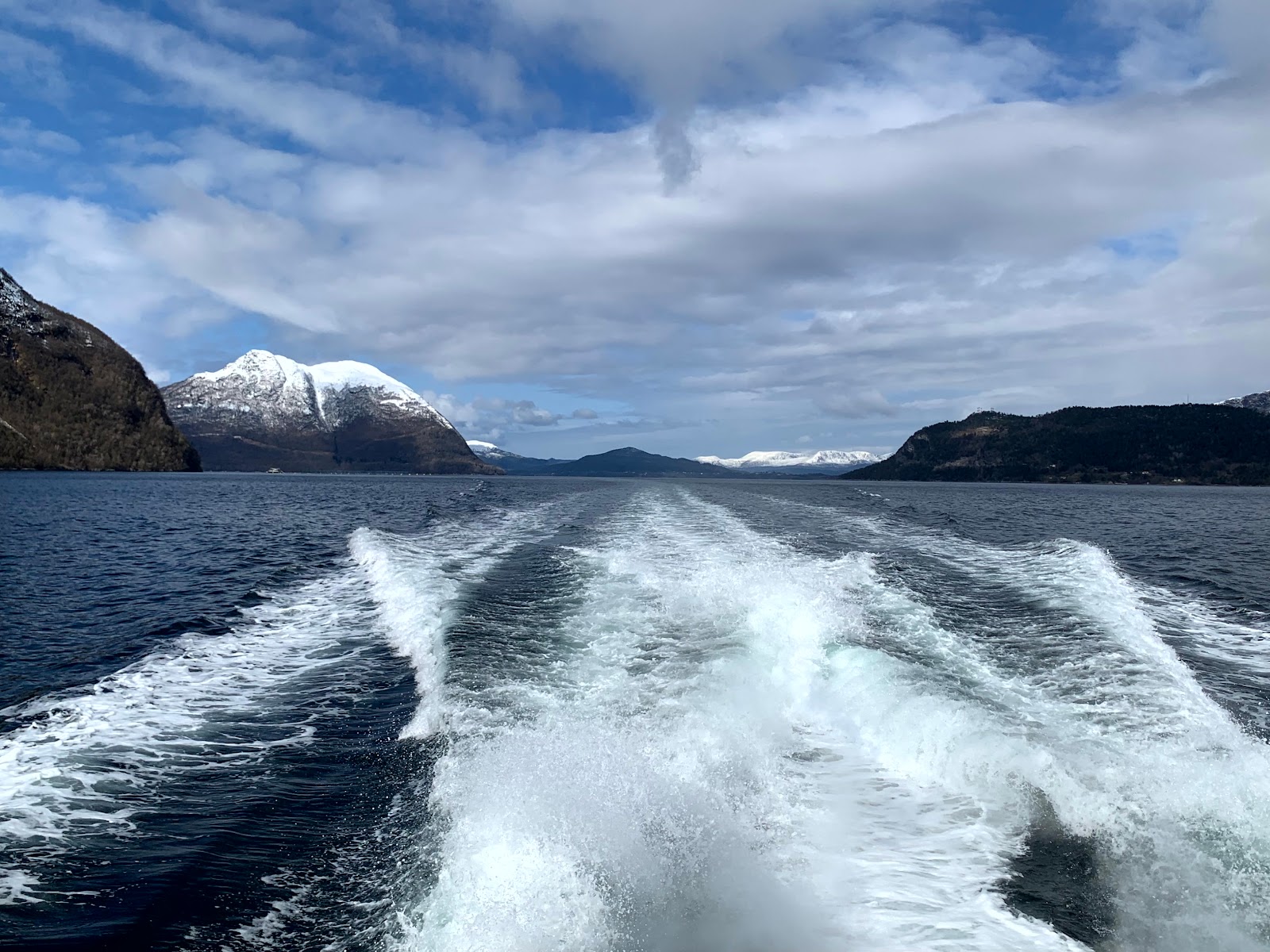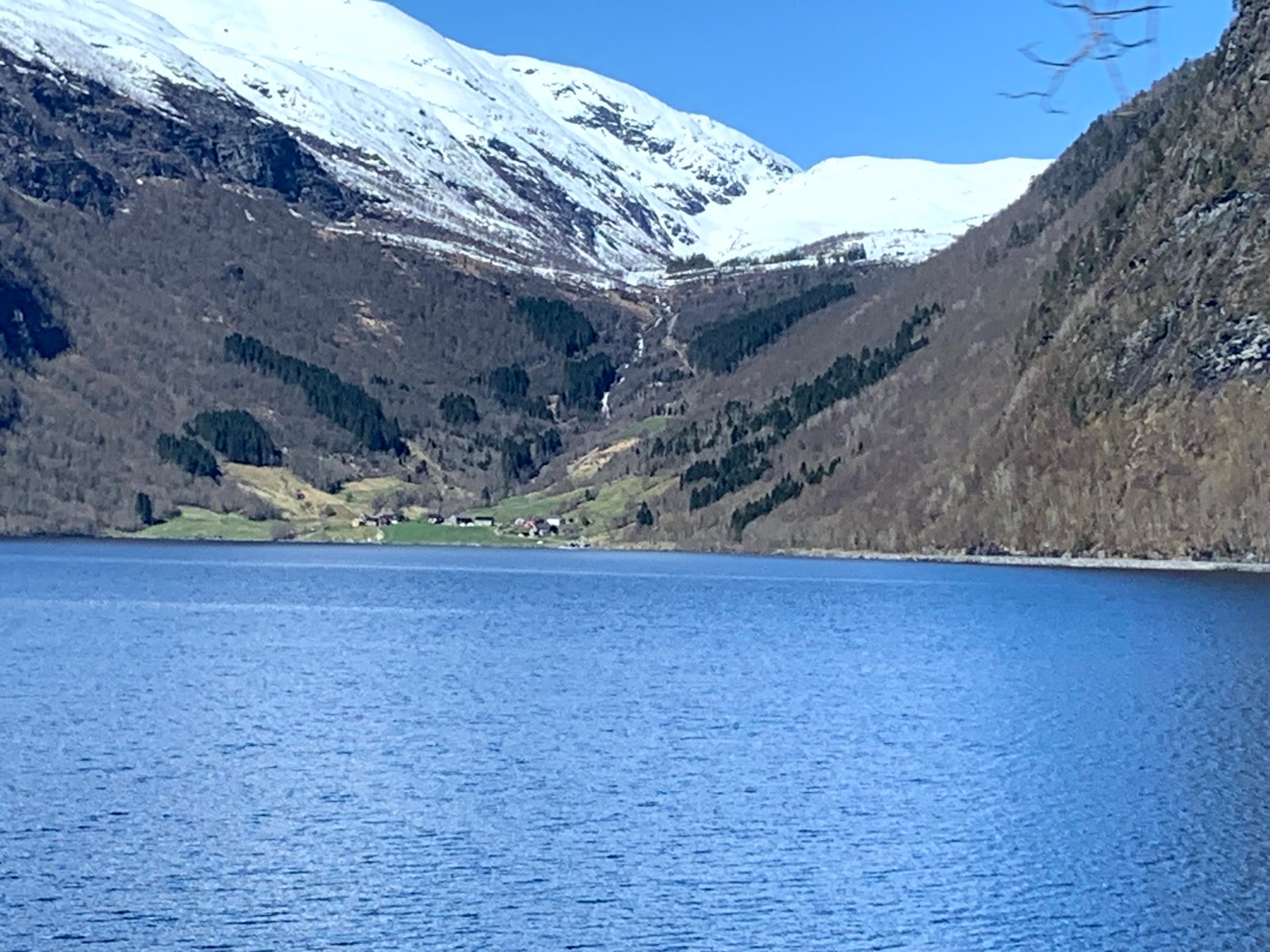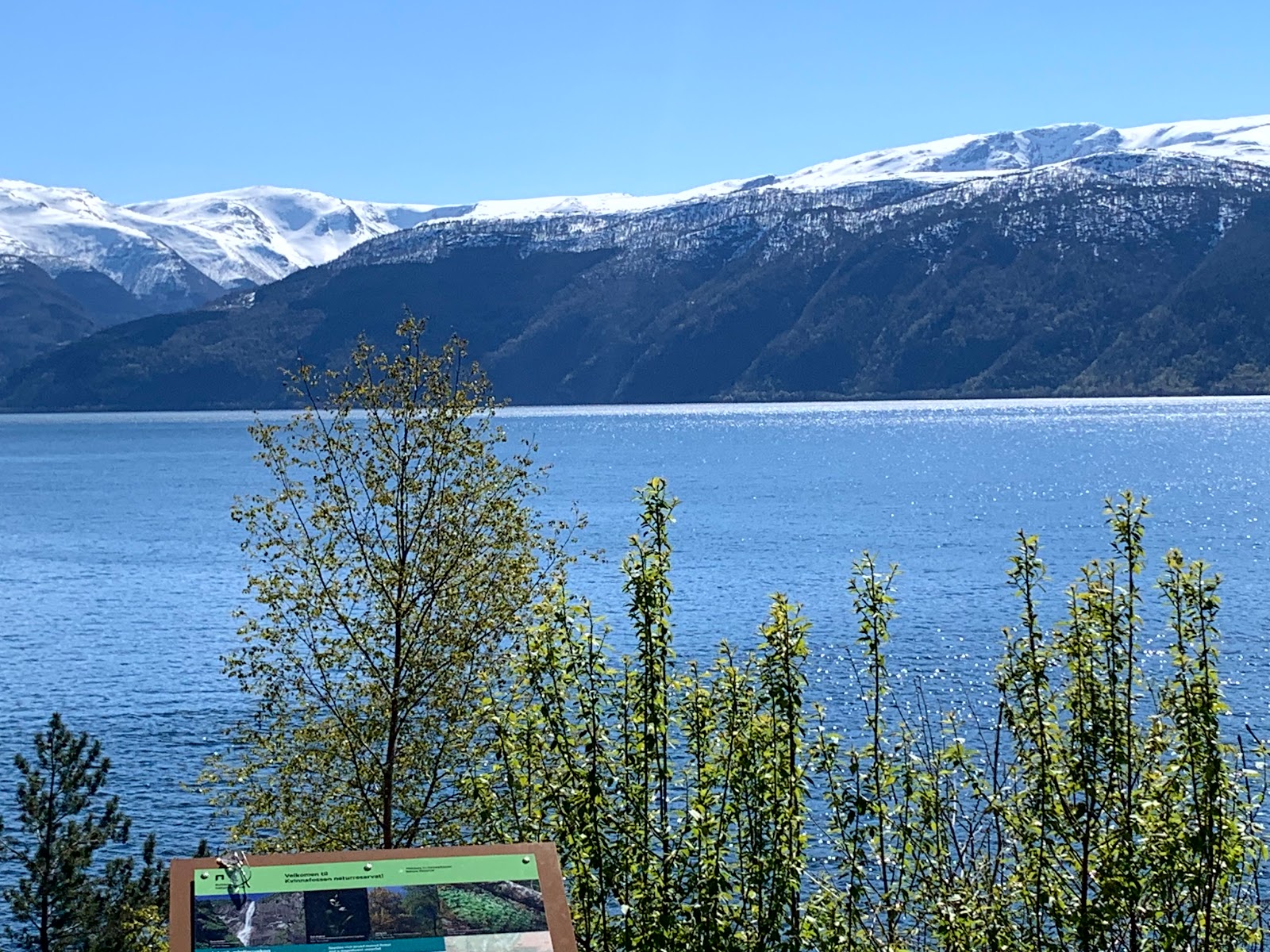The Fjords
The Western Fjords
Our first leg was a ferry from Alesund to Geiranger. I say
ferry, but it was a tour boat that took passengers from Alesund on a day long
round trip into the Geirangerfjord. They did offer one-way tickets and we used
it as our way to get to Geiranger. It was a one-way journey of about three
hours through three fjords culminating in the final 12 miles through the UNESCO
protected Geirangerfjord.
We’ve talked about the question of ‘how do you describe fjords with words.’ The technical aspect includes the definition of a fjord. Per Wikipedia, "in physical geography, a fjord or fiord is a long, narrow inlet with steep sides or cliffs, created by a glacier."
Fjords, by virtue of their connection to the ocean are salt water. Even as they reach inland
for 50 miles or more, they are still salty although the degree may vary
depending upon whether the fjord is fed by freshwater streams and rivers. We also
noticed that some like the Geirangerfjord had very little change from the tides
but others like the Sognefjord tended to rise and fall with the tides. While we
were there, it appeared to be a three to four foot difference between high and
low tides. I guess that fjords, like
people, each have unique personalities.
We’ve seen examples of fjords such
as the Hood Canal in Washington. We’d also seen pictures of the Norwegian
fjords. It’s not like we were not prepared for seeing fjords. We certainly
thought we were. What we were not prepared for was the sensory overload from the overwhelming enormity of our new environment.
As we moved along through the fjords,
the width narrowed, and the shear walls grew taller and taller. The depth was
usually about the same as the height of the sides of the fjords. As we entered
the Geirangerfjord, it was lightly snowing giving an eerie peace to our
presence. It was not difficult staying in the present, you were consumed by it.
Our energies were spent on humanly processing our individual insignificance with
respect to the glacial carving and with respect to the earliest inhabitants
from the woolly mammoths to the earliest human settlers. This was a difficult
place to eek a survival out of the land and the surrounding sea. This is also where
we stumble and run out of words, knowing you can’t do justice to the beauty and
magnitude of the place. The solitude made it even more surreal. We’ll let the
pictures do the talking, although they too, fail to convey what we saw with our eyes and hearts.
We were dumped back into reality as
we arrived in the town of Geiranger and joined the tour group for a whirlwind
tour of the visitors center and the observation peak above town.
After two nights in Geiranger, we boarded an 8:00 am ferry for Hellesylt and on to Olden to the Nordfjorden.
We had originally planned our journey to give us a full day in Olden with the opportunity to visit the glacier above town. But due to adding the Lofoten islands, we lost that day. No regrets on that one though the glacier will have to wait for us.
We got to Sognefjord and stayed in
Leikanger for two nights. Sognefjord is also nicknamed the King of the fjords.
It is the longest at 204 kilometers (127 miles) inland from the Atlantic and is
the deepest at 1,308 meters. (4,278 feet) There are many smaller fjords shooting
from the main channel. Surrounded by snow-capped mountains we were glad to have
a day to decompress. It’s also one of the stops on the ferry running to Bergen.
We left Alesund with a plan to travel through the western
fjords using only public transportation. Ferries and buses. It was the
off-season. In most cases, there were only two buses a day working the routes
we wanted to travel. Starts were early and waits were long. But it was so much
fun. We met warm welcoming people who enjoyed a laugh on us when we tried to
pronounce the name of their towns. Only once did we run into someone who knew
no English. This happened at the airport in Molde as I was returning the rental
car. The airport was empty except for one man who continued to talk to me in
Norwegian even though he could tell that I did not understand a single word.
Almost comical but I continued to be courteous and listened. He also talked
with his hands but that did not help. For probably 20 minutes, I stood there
and listened, until I was able to get through to a taxi to get a ride back.
When we arrived in Geiranger, we discovered that there was a cruise ship in town. Our reservation for a cabin at a campground two kilometers from town made perfect sense. With a cruise ship in town, the town would be very busy. We’d been told, just take a taxi to the campgrounds. What we had not been told was that there was only one taxi in town and that his day was over once the cruise ship left. So here we are, two septuagenarians with backpacks and rolling luggage, drawing a visual of walking up a two-kilometer paved road with no sidewalks and lots of traffic. We knew we had to be resourceful. There was no car rental available, but we noticed the e-mobility buggies for rent. We talked to guy running it who was Polish and had just opened for the season. We cut a deal. Three of them would drive us out. One buggy each for Susanne, Malcolm and our luggage. Problem solved, or so we thought. Then Susanne climbed into the back of one and I climbed into the back of another. We had no idea of the logistics or mechanics for how we’d get out of those buggies. To people standing around as we disembarked, it probably had all the humor of a circus car Volkswagen with 15 clowns getting out. I know we couldn’t stop laughing at ourselves.
At least we had a peaceful evening watching the Rotterdam
sail away and an early evening going to bed. We realized during the night that
maybe the cabin was not the best idea. It was -11o C outside (12
o F.) The cabin leaked. There was a small electric baseboard heater that
was way undersized for the cabin. We also foresaw the need for a taxi the next
morning at 7:00 to get us to the ferry. Flashing thoughts about e-buggies went
through our heads. Brighter minds prevailed and we moved to a hotel in town.
Turns out preseason has its advantages too. We got a great room overlooking the
fjord at a reasonable rate and enjoyed a great night of sleep.
Getting to the ferry was never easier. A 300-meter walk. The
ferry pulled away and we had another wonderful tour of the Geirangerfjord. I
don’t believe you could ever get tired of this view.
Hellesylt was our first stop along the way. It’s where the
ferry ended and where the first of several bus connections began. We got there
at 9:00 am and were ready to wait for our 1:45 pm bus. This is all part of the
joy of public transportation. We were happy to discover a grocery store and sat
outside and ate breakfast. Across the road was a school. Kids were out at
recess and for the first time that either of us remembered, there were kids
jumping rope. Two kids twirling the rope on each end, and kids jumping in,
taking a few jumps, and then jumping out. We were wondering if kids in the US still jump rope at recess.

At noon we decided that the pizza place sounded good, so we
ate it on a park bench right beside the fjord. We hopped on our bus. We drove
through some snow-covered rolling hills and enjoyed the change of scenery.
As we rode along, we discovered that
Norway has been able to take advantage of tunneling through mountains to
shorten the path between places. It also made sense due to the terrain and the
likelihood of rock sides and avalanches. Over the next two days of travel, we
passed through probably 20 tunnels including one that was 8 kilometers (5 miles)
long. It helps that the traffic in this area of Norway is light enough to be
supported by two lane roads. Maximum speed in most of this area were 60 to 70
kilometers per hour so nothing ever felt rushed.
From Olden to the town of Skei (pronounced shy) was one of the most incredibly beautiful drives either of us have ever been on. We kept climbing to the top of the mountains. Twisting and turning. One snow-capped peak after another. Peaks at the top of the glacier park that never melted. Skiing areas. But as we came over the pass and started descending into a valley we could not believe it. We’ve never seen anything as picturesque. We know we can’t do it justice with pictures, but it is certainly burned in our minds.
It seemed that we were on our phones all the time. We were searching for maps, looking up bus service schedules, trying to understand our location or details about something near us. It dawned on us that map information is so incomplete with only two dimensions. Throw in the dimension of elevation, add views of distant mountains, and then add snowcaps, and we were blown away. We knew the drives would be something, but we didn’t know that they were the trip itself.
Places We Stayed and People We Met
We’d like to give a shoutout to two
places we stayed. The Olden Fjordhotel and the Leikanger Fjordhotel. Both have
signs of age that appear on the surface. But both have heart that makes up for
any external blemishes. The staff at both went out of their way to make us
comfortable. At the Leikanger Fjordhotel, our host there was so kind as to
drive us 10 kilometers to see a beautiful waterfall. We left on the morning ferry
before they opened. As we passed the reception desk, we found a package of croissants
and pastries for us to take with us and a beautifully written thank you note
from the staff. We cannot thank them enough and would encourage anyone thinking
of traveling to include either or both of them on your itinerary.
Also, at the Leikanger hotel we
arrived as a wedding reception was in progress. It went from about 3 pm until
around 1:30 am. We met some of the participants and had great conversations
with them. The one thing that they did in the morning was to wake up and meet
at 8:30 by the fjord and take a jump into the fjord. We took a pass on that one,
but we could tell they enjoyed it. Out of respect for their privacy, we did not
post any pictures of the wedding or the fjord dive.
In the morning, one of the participants we met introduced us to his mother who was from Leikanger. She was a US Army brat and was raised all over the world. She'd gone to Norway in the 1960s as an exchange student. Years later she decided to move back and has lived there for over 30 years. She is the town mid-wife doing most of the baby deliveries and working with women's health issues. We had a wonderful conversation getting to know each other.
During another conversation we discovered that another friend who we met there was born and raised on a farm outside of Balestrand (which in itself is not a big town.) She sees her life growing up as a wonderful memory. You may expect that the isolation would have affected her but she had wonderful friends and all the same fun things to do that we had as kids. We are all definitely more alike than different and when we celebrate our likeness, we find common ground.
A special word for the Fjords Mind-blowing!



























































What we have loved, about your blogs, are your comments about how much more we are similar than different, even though brought up in different parts of the world:--- this is the greatest learning from travelling the world. Seeing these pictures we can also understand how these views will be burned in your minds forever!!!
ReplyDelete